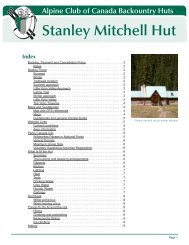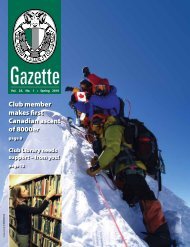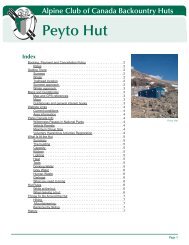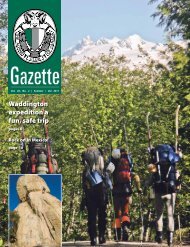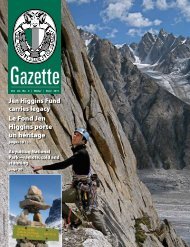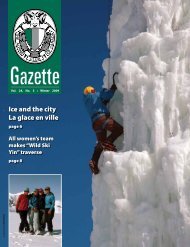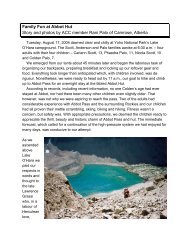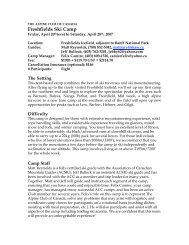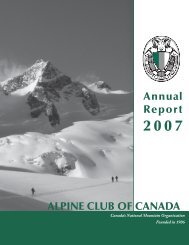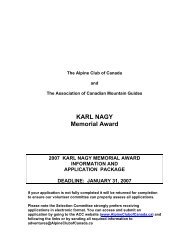Winter 2010 - The Alpine Club of Canada
Winter 2010 - The Alpine Club of Canada
Winter 2010 - The Alpine Club of Canada
- No tags were found...
Create successful ePaper yourself
Turn your PDF publications into a flip-book with our unique Google optimized e-Paper software.
Mountaineers and Banff National Park<br />
by Zac Robinson<br />
It should be hardly surprising that<br />
James Bernard Harkin (1875-1955), the<br />
first commissioner <strong>of</strong> the Dominion<br />
Parks Branch and celebrated “father” <strong>of</strong><br />
national parks in <strong>Canada</strong>, generously<br />
cited the writings <strong>of</strong> mountain climbers<br />
in promoting the first Dominion parks<br />
established in the Rocky Mountains. <strong>The</strong><br />
charm and attractiveness <strong>of</strong> the range,<br />
which justified and compelled pride <strong>of</strong><br />
country, were best related, according to<br />
Harkin, “by those whom the world recognizes<br />
as having the right to speak with<br />
authority upon the subject <strong>of</strong> mountains<br />
and scenic attractions”. Privileged players<br />
in the realm <strong>of</strong> aesthetics, mountaineers<br />
were widely regarded as arbiters <strong>of</strong> taste<br />
and thus picturesque scenery in the<br />
Rockies.<br />
But Banff National Park, celebrating<br />
its 125th anniversary in <strong>2010</strong>, has always<br />
had a special relationship with mountain<br />
climbers. Its earliest boundaries—the<br />
first, in 1885, enclosed a reserve <strong>of</strong> 26<br />
square kilometres surrounding hot springs<br />
near Sulphur Mountain; expansion in<br />
1887 brought 673 square kilometres,<br />
named Rocky Mountains Park, under<br />
Dominion control—were drafted by some<br />
<strong>of</strong> <strong>Canada</strong>’s earliest climbers: surveyors.<br />
<strong>The</strong> mountains provided new challenges<br />
and pleasures for the pr<strong>of</strong>ession. And<br />
the demands <strong>of</strong> mapping in the Rockies<br />
meant surveyors also played a major role<br />
in the evolution <strong>of</strong> mountaineering pursuits<br />
in the range.<br />
Surveyors had company in the<br />
Members gather in front <strong>of</strong> the Banff <strong>Club</strong> House.<br />
country’s western mountains: Swiss<br />
guides and a whole cohort <strong>of</strong> experienced<br />
international climbers. <strong>The</strong>ir activities,<br />
<strong>of</strong> course, along with a hefty dose <strong>of</strong><br />
homegrown nationalism, sparked the<br />
genesis <strong>of</strong> the <strong>Alpine</strong> <strong>Club</strong> <strong>of</strong> <strong>Canada</strong><br />
(ACC), whose Banff <strong>Club</strong>house—built<br />
halfway between the town and the Upper<br />
Hot Springs—opened in July, 1909. Its<br />
headquarters gave permanent visibility<br />
to the <strong>Club</strong> and to mountaineering in<br />
<strong>Canada</strong>. Indeed, much <strong>of</strong> early development<br />
<strong>of</strong> mountaineering in the Rockies<br />
was planned there, and its distinctive red<br />
ro<strong>of</strong> quickly became a recognizable feature<br />
from town, a speck <strong>of</strong> colour against<br />
the green, pine-clad slopes <strong>of</strong> Sulphur<br />
Mountain. Long-time Banff resident<br />
Eleanor Luxton (1908-1995) remembered<br />
the <strong>Club</strong>house as “a delightful place, and<br />
much used by all climbers”.<br />
<strong>The</strong> <strong>Club</strong> became the park’s strongest<br />
advocate by the 1920s. Decades <strong>of</strong><br />
“parkmaking”—the building <strong>of</strong> roads and<br />
bridges, the establishment <strong>of</strong> a townsite,<br />
and the provision <strong>of</strong> tourist facilities—<br />
had all contributed to make Banff a premier<br />
destination. But tourism, then, was<br />
seen as neither a detriment to the park<br />
nor its priority; for years, it was merely<br />
the financial icing on the cake. Instead,<br />
the park needed saving from resource<br />
extraction. Coal mining and lumbering,<br />
which were accepted practices under<br />
early parks policy, had grown increasingly<br />
divergent from the conservationist sentiment<br />
sweeping the country. For Harkin<br />
photo from the ACC collection.<br />
and his fledgling Parks Branch, formed in<br />
1911, the future <strong>of</strong> parks was in the “business<br />
<strong>of</strong> selling scenery”. For the ACC, the<br />
threat was hydroelectric development.<br />
It was a fight that determined the<br />
future <strong>of</strong> <strong>Canada</strong>’s national parks. Calgary<br />
Power Company (later TransAlta),<br />
which already had power dams on the<br />
Bow River’s Horseshoe Falls, at Lake<br />
Minnewanka and at Kananaskis Falls,<br />
needed more power in 1923. Pressure<br />
mounted for further operations within<br />
the park. A proposal to dam the Spray<br />
River, just east <strong>of</strong> the town <strong>of</strong> Banff,<br />
gained momentum. Its proponents rallied.<br />
If Harkin needed an ally, he found it in<br />
Arthur Oliver Wheeler (1860-1945), a<br />
surveyor by pr<strong>of</strong>ession and the fiery director<br />
<strong>of</strong> the ACC.<br />
At its Annual Meeting in 1923, held<br />
at the Larch Valley Camp, near Lake<br />
Louise, Wheeler and the ACC formed a<br />
second organization, the National Parks<br />
Association. It was the country’s first<br />
non-government watchdog for parks, and<br />
the group quickly made its resolve known<br />
to the Minister <strong>of</strong> the Interior: “That a<br />
National Parks Association for <strong>Canada</strong><br />
be formed with objects consisting <strong>of</strong> the<br />
conservation <strong>of</strong> the Canadian National<br />
Parks for scientific, recreational and<br />
scenic purposes, and their protection from<br />
exploitation for commercial purposes”.<br />
A letter campaign followed and over<br />
the next seven years the Spray Lakes<br />
controversy—likened by historians to the<br />
famous Hetch Hetchy dam debates in<br />
Yosemite National Park—attracted attention<br />
from all levels <strong>of</strong> government.<br />
Resolution was bittersweet. In<br />
negotiation with the Prairie provinces,<br />
the Canadian government enacted<br />
new legislation in 1930—the National<br />
Parks Act—to ensure parks remained<br />
“unimpaired for the enjoyment <strong>of</strong><br />
future generations”. It was a landmark<br />
achievement. Mining was no longer<br />
permitted, nor were commercial forestry<br />
or hydroelectric schemes. For Harkin and<br />
Wheeler, however, the legislation came at<br />
a cost. Lands <strong>of</strong> “substantial commercial<br />
value”—Canmore and its coal mines,<br />
Exshaw with its cement plant, and the<br />
Spray Valley with its hydro potential, for<br />
example—were taken out <strong>of</strong> the newly<br />
named Banff National Park. Boundaries



